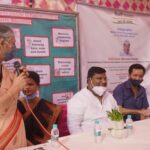About 1 in 10,000 people are born with this condition
New Delhi, June 2, 2018:
As per estimates, of all the Hemophilia cases in India, only about 15% are identified, and the remaining lie undiagnosed. While there are about 16,000 patients registered with this condition in the country, reports indicate that the number could be as much as 7 times more. About 50% of those with this condition live in India and 70% of the PwH (People with Haemophilia) do not have adequate knowledge or access to treatment, which further exacerbates the risk of death.
Hemophilia is an inherited bleeding disorder in which a person lacks or has low levels of certain proteins called ‘clotting factors’ and the blood doesn’t clot properly as a result. This leads to excessive bleeding. There are 13 types of clotting factors, and these work with platelets to help the blood clot. About 1 in 10,000 people are born with this condition.
Speaking about this, Padma Shri Awardee Dr K K Aggarwal, President Heart Care Foundation of India (HCFI) said, “In hemophilia, people bleed easily, and blood takes a longer time to clot. Such people can also experience spontaneous or internal bleeding and often have painful, swollen joints due to bleeding into the joints. This is a rare but life-threatening condition. There are three forms of this condition: Hemophilia A, B, and C. Hemophilia is an inherited genetic condition and is caused due to a defect in the gene that determines how the body makes factors VIII, IX, or XI. These genes are located on the X chromosome, making hemophilia an X-linked recessive disease. Hemophilia A and B are more common in males than females because of genetic transmission. Hemophilia C is an autosomal inherited form of the disease, meaning that it affects males and females equally.”
Symptoms that indicate the need for immediate medical help include a severe headache, vomiting repeatedly, neck pain, blurred or doubled vision, extreme sleepiness, and continuous bleeding from an injury.
Adding further, Dr Aggarwal who is also the Group Editor of IJCP, said, “There is no known cure for hemophilia. The line of treatment in case of an internal-bleed or external-bleed is to supplement the patient’s AHF level by fresh blood transfusion. If one is injured severely, the quantity of blood required will be more than the load that the heart can take. This creates the need for concentrates of AHF. Fresh frozen plasma is twice as rich as fresh blood and cryoprecipitate is twice as rich as FFP. Although both are manufactured in India, in many cases the load is more than what the body can take.”
It is possible to live with hemophilia and manage the condition with the following tips.
- Adequate physical activity can help maintain body weight and improve muscle and bone strength. However, those with hemophilia should avoid physical activity that can cause injury and resultant bleeding.
- Avoid blood-thinning medication such as warfarin and heparin. It is also better to avoid over-the-counter medicines like aspirin and ibuprofen.
- Clean your teeth and gums thoroughly. Get tips from your dentist on how to do this without making the gums bleed.
- Get tested regularly for blood infections and get your doctor’s advice on hepatitis A and B vaccinations.







